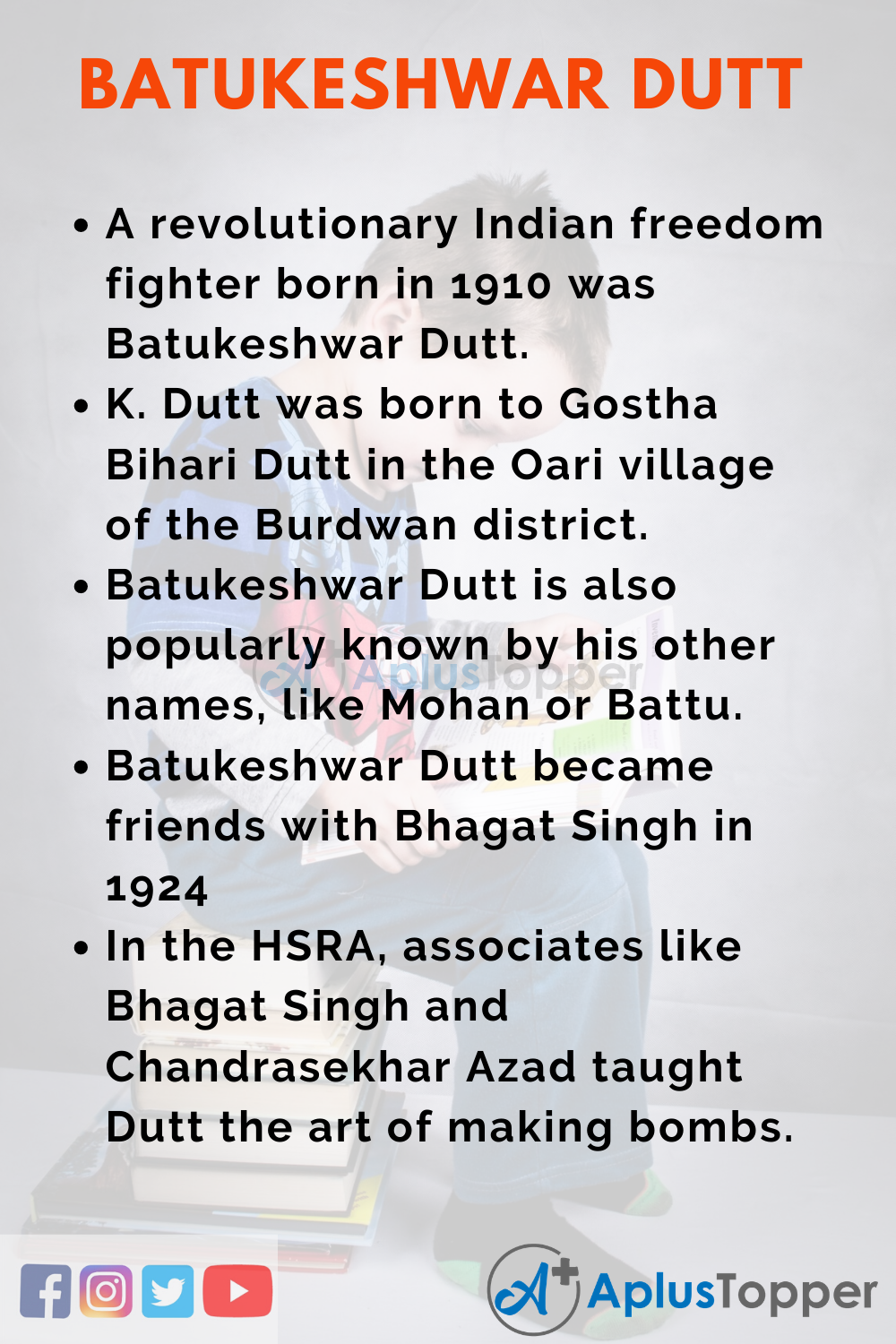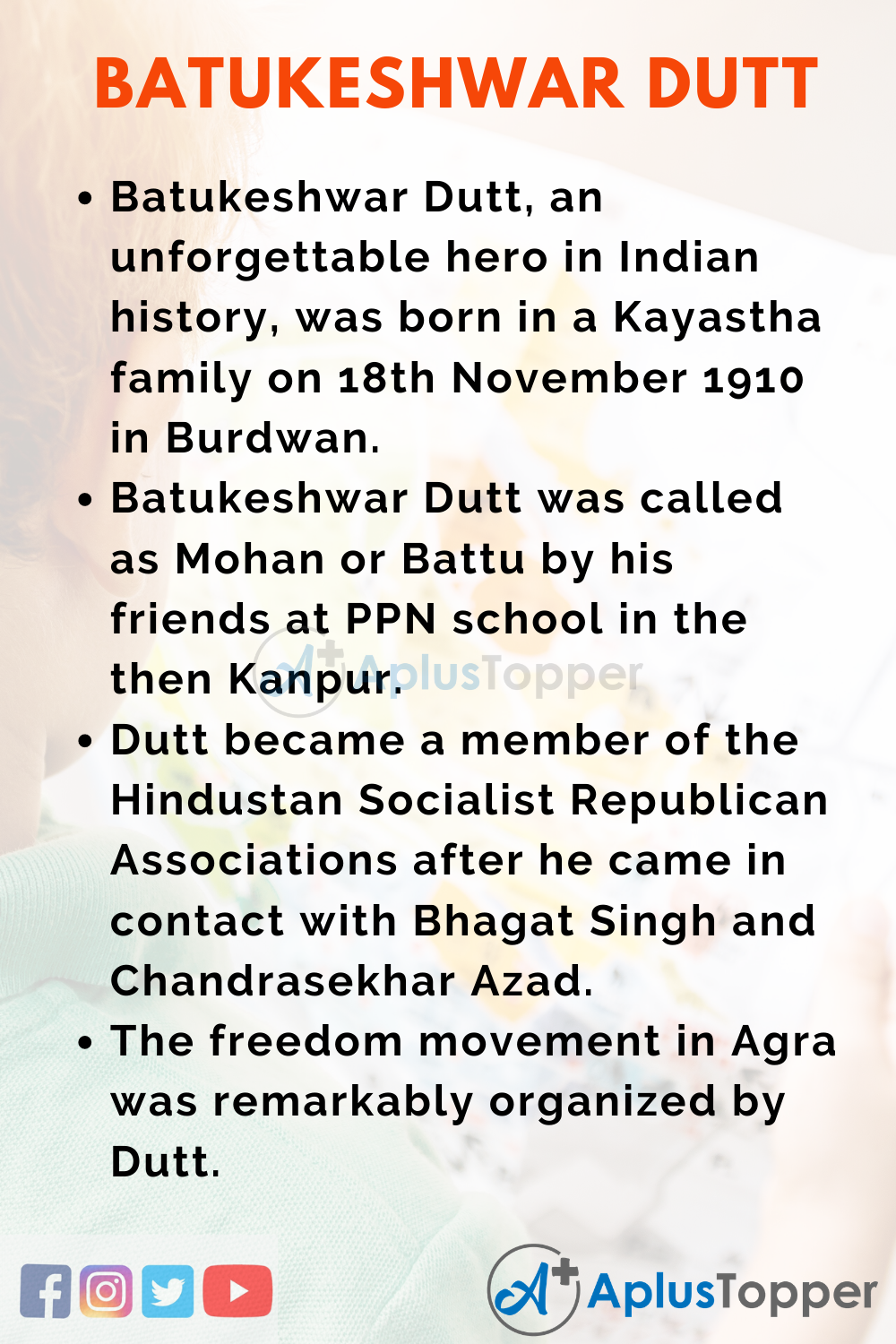10 Lines On Batukeshwar Dutt: A significant figure in the history of India was Batukeshwar Dutt. The tales of Batukeshwar Dutt’s bravery as a Bengali Freedom Fighter should not be forgotten. Dutt’s strong will and eagerness to defeat the British rule what could be noticed through his contributions. It is essential to recognize the contributions made by those ‘Unsung Bravehearts’ like Dutt. Bhagat Singh in the company of Batukeshwar Dutt could successfully attack the Central Legislative Assembly with smoked bombs to stop the passing of the British introduced Bill that would’ve inflicted only harm to Indians. Batukeshwar Dutt’s moving chants of Inquilab Zindabad are unforgettable.
You can read more 10 Lines about articles, events, people, sports, technology many more.
Set 1 – 10 Lines On Batukeshwar Dutt for Kids
Set 1 is helpful for students of Classes 1, 2, 3, 4 and 5.
- A revolutionary Indian freedom fighter born in 1910 was Batukeshwar Dutt.
- K. Dutt was born to Gostha Bihari Dutt in the Oari village of the Burdwan district.
- Batukeshwar Dutt is also popularly known by his other names, like Mohan or Battu.
- Batukeshwar Dutt became friends with Bhagat Singh in 1924
- Batukeshwar Dutt joined the Hindustan Socialist Republic Association party.
- In the HSRA, associates like Bhagat Singh and Chandrasekhar Azad taught Dutt the art of making bombs.
- HSRA took charge of revolt against the 1915 Defense of India Act passed by the British.
- It was on 8th April 1929 that Dutt along with Bhagat Singh that they entered in Central Legislative Assembly in New Delhi.
- But unfortunately, they couldn’t escape from the Central Legislative Assembly and were imprisoned for life.
- Bhagat Singh and Dutt started a hunger strike inside the jail to restore the fundamental rights of the prisoners.

Set 2 – 10 Lines On Batukeshwar Dutt for School Students
Set 2 is helpful for students of Classes 6, 7 and 8.
- The lifespan of Batukeshwar Dutt was from 18th November 1910 to 20th July 1965.
- Dutt was a graduate of the PPN high school of Kanpur.
- Dutt became associated and friends with Bhagat Singh, and later, he joined HSRA.
- The Defense of India Act of 1915 passed by the British gave them the power to control the revolutionary activities which Dutt and others at HSRA opposed highly.
- Along with the British passed Act, what made the HSRA and Dutt furious was the death of Lala Lajpat Rai in the lathi charge by British officers.
- After the bomb-explosion attack 1929 made on 18th November, Bhagat Singh and Dutt were imprisoned in the Cellular Jail of Andaman.
- It was Dutt who surrendered to the police after bomb-explosion in the Central Legislative Hall.
- The prisoners were abused by Indian political prisoners, and against which Bhagat Singh and Dutt took action.
- After Dutt was released from prison, he became ill with tuberculosis.
- Even in that unhealthy condition, Dutt participated in Mahatma Gandhi’s Quit India Movement and was again sent to jail for four more years.
Set 3 – 10 Lines On Batukeshwar Dutt for Higher Class Students
Set 3 is helpful for students of Classes 9, 10, 11, 12 and Competitive Exams.
- Batukeshwar Dutt, an unforgettable hero in Indian history, was born in a Kayastha family on 18th November 1910 in Burdwan.
- Batukeshwar Dutt was called as Mohan or Battu by his friends at PPN school in the then Kanpur.
- Dutt became a member of the Hindustan Socialist Republican Associations after he came in contact with Bhagat Singh and Chandrasekhar Azad.
- The freedom movement in Agra was remarkably organized by Dutt.
- In HSRA, Dutt was trained to make bombs and explosives that they were going to use to propagate their point.
- On 8th April of 1929, Dutt and Bhagat Singh attacked the Central Legislative Assembly with explosives.
- It was someone as brave as Dutt, who later surrendered to the British and was taken to Andaman’s Cellular Jail.
- After Dutt was released from his imprisonment, he suffered from TB, yet he took part in Mahatma Gandhi launched Quit India Movement.
- Dutt was again imprisoned for another four years.
- After battling his illness for a long time, Dutt died on 20th July 1965 in AIIMS hospital.

FAQ’s on 10 Lines On Batukeshwar Dutt
Question 1.
What was a famous slogan in the leaflets that Dutt and Bhagat Singh threw after the bombing?
Answer:
It takes a loud sound to make the deaf hear. This was the slogan inside the leaflets thrown by Dutt and Bhagat Singh in the Central Legislative Assembly.
Question 2.
Why Batukeshwar Dutt is called an unsung hero?
Answer:
Even though Batukeshwar Dutt’s contributions were nothing less than that of Bhagat Singh’s, yet it is Bhagat Singh who is only a widely celebrated revolutionary by the children and youngsters among the two. Therefore, Dutt remains our unsung hero even after being part of that legendary bombing just as Bhagat Singh.
Question 3.
Why did Batukeshwar Dutt and Bhagat Singh have to surrender?
Answer:
They surrendered by choice because Singh and Dutt both wanted their voices to be heard.
Question 4.
Describe the incident of the bombing of the Central Legislative Assembly?
Answer:
On 8th April 1929, when the British official members of the Central Legislative Assembly had gathered for their daily discussions, from the visitor’s gallery, someone threw an object and shouted ‘Inquilab Zindabad.’ Soon after, smoke started being released from the thrown object and filled the hall. Soon Bhagat Singh and Batukeshwar Dutt started throwing leaflets which contained a powerful slogan. But later both of them surrendered to the British so that they could express what they wanted for this country.
